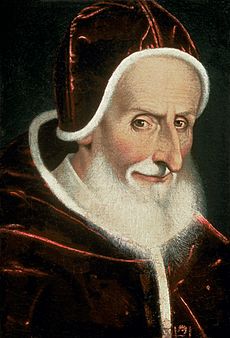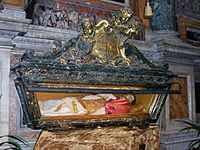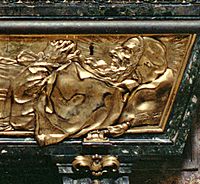Pope Pius V facts for kids
Quick facts for kids Pope Saint Pius V |
|
|---|---|
| Bishop of Rome | |
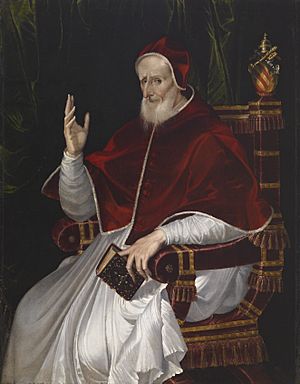
|
|
| Church | Catholic Church |
| Papacy began | 7 January 1566 |
| Papacy ended | 1 May 1572 |
| Predecessor | Pius IV |
| Successor | Gregory XIII |
| Orders | |
| Ordination | 1528 |
| Consecration | 14 September 1556 by Giovanni Michele Saraceni |
| Created Cardinal | 15 March 1557 |
| Personal details | |
| Birth name | Antonio Ghislieri |
| Born | 17 January 1504 Bosco Marengo, Duchy of Milan |
| Died | 1 May 1572 (aged 68) Rome, Papal States |
| Previous post |
|
| Motto | Utinam dirigantur viæ meæ ad custodiendas justificationes tuas ("O that my ways may be directed to keep thy justifications") |
| Coat of arms |  |
| Sainthood | |
| Feast day | 30 April |
| Venerated in | Catholic Church |
| Beatified | 1 May 1672 Saint Peter's Basilica, Papal States by Pope Clement X |
| Canonized | 22 May 1712 Saint Peter's Basilica, Papal States by Pope Clement XI |
| Attributes | |
| Patronage | |
| Other Popes named Pius | |
Pope Pius V (born Antonio Ghislieri) was the leader of the Catholic Church and the Papal States from 1566 to 1572. He was born on January 17, 1504, and died on May 1, 1572. Today, he is honored as a saint in the Catholic Church.
Pope Pius V is well-known for his important work during the Council of Trent. This council helped reform the Catholic Church during a time of big changes. He also played a key role in the Counter-Reformation, which was the Church's response to the rise of Protestantism. He helped make the way Mass was celebrated more standard across the Church.
Before becoming pope, Antonio Ghislieri was a cardinal. He was known for being very strict about Church rules. He even spoke up against his predecessor, Pope Pius IV, who wanted to make a 13-year-old relative a cardinal.
Pope Pius V also took strong actions against Elizabeth I of England. He declared her excommunicated from the Church. He also helped create the Holy League, an alliance of Catholic countries. This group fought against the growing power of the Ottoman Empire in Eastern Europe. Even though they were outnumbered, the Holy League won a famous victory at the Battle of Lepanto in 1571. Pope Pius V believed this victory was a miracle. He then created the feast day of Our Lady of Victory to celebrate it.
Biography
Early Life and Church Service
Antonio Ghislieri was born on January 17, 1504, in Bosco, which is now part of Italy. When he was 14, he joined the Dominican Order and took the name Michele. He became a priest in 1528. For 16 years, he taught at Pavia. He was known for being very disciplined and focused on prayer.
Because of his strong beliefs, he was called to Rome in 1550. There, he worked on several missions for the Holy Office, which dealt with Church teachings. In 1556, he became the Bishop of Sutri. He was also chosen to be an inquisitor, investigating matters of faith in Milan and Lombardy. A year later, in 1557, he became a cardinal and was named the chief inquisitor for all of Christendom.
Under Pope Pius IV, he became the Bishop of Mondovì. He often went to Rome and showed his strong dedication to Church matters. He even disagreed with Pope Pius IV when the Pope wanted to make a 13-year-old a cardinal. This disagreement led to some limits on his power as an inquisitor.
Becoming Pope
After Pope Pius IV died, the cardinals met to choose a new pope. On January 4, 1566, rumors spread that King Philip II of Spain supported Cardinal Ghislieri. This helped Cardinal Borromeo and his allies, who already wanted Ghislieri to be the next pope. More and more cardinals agreed, and Ghislieri was elected pope on January 8, 1566. He chose the name Pope Pius V. He was crowned ten days later, on his 62nd birthday.
Cardinal Borromeo later wrote about the election. He said he had "high esteem" for the new pope because of his "singular holiness and zeal." He believed these qualities meant Pius V would be a good pope and make everyone happy.
Pope Pius V's Time as Pope
| Papal styles of Pope Pius V |
|
|---|---|
 |
|
| Reference style | His Holiness |
| Spoken style | Your Holiness |
| Religious style | Holy Father |
| Posthumous style | Saint |
During his time as pope, Pius V worked on reforming the Church from the inside. He also faced challenges from the spread of Protestant ideas in the West and the advance of Turkish armies from the East.
Church Rules and Discipline
Pius V knew that he needed to improve discipline and morality in Rome. He immediately worked to reduce the costs of the papal court. He also made rules for inns and stressed the importance of Church ceremonies, especially the Mass.
His main goals were to strengthen the Inquisition and make sure the rules from the Council of Trent were followed.
Changes to the Mass
To follow a decision from the Council of Trent, Pope Pius V made the 1570 edition of the Roman Missal the standard for the Latin Church. This meant that this form of the Mass had to be used everywhere, unless a different Mass liturgy had been in use since before 1370 AD. This version of the Mass stayed mostly the same for 400 years.
Supporting Thomas Aquinas
In 1567, Pius V declared Thomas Aquinas a "Doctor of the Church." This is a special title given to saints who have made important contributions to theology. Pius V also ordered the first complete collection of Aquinas's writings. This collection is often called the editio Piana in honor of the Pope.
The Holy League and Battle of Lepanto
Pius V helped create the Holy League to fight against the Ottoman Empire. This led to the famous Battle of Lepanto on October 7, 1571. The combined Christian fleet, led by Don John of Austria, won a great victory. It is said that Pius V miraculously knew the battle was over while he was in Rome. To celebrate this victory, he created the Feast of Our Lady of Victory.
Pius V also helped pay for the building of Valletta, the capital city of Malta. He sent his military engineer, Francesco Laparelli, to design the city's strong walls.
Dealing with Protestantism
When Pius V became pope, Protestantism had spread across England, Scotland, and parts of Germany, the Netherlands, and France. Only Spain, Ireland, Portugal, and Italy remained strongly Catholic. Pius V was determined to stop Protestantism from spreading into Italy.
In France
In France, Pius V worked to oppose the Protestant Huguenots. He ordered some bishops to be dismissed and canceled a royal law that allowed Protestants to worship outside of churches. He also brought back the Roman catechism and worked to restore Church discipline.
Elizabeth I of England
Pius V reacted strongly when Elizabeth I of England became the head of the Church of England. He supported Mary, Queen of Scots and her followers who tried to take over England. After a Catholic uprising in England failed, Pius V issued a papal bull called Regnans in Excelsis on April 27, 1570. This document declared Elizabeth I a heretic and said that her subjects no longer had to obey her. It also stated that anyone who did not deny loyalty to her would be excommunicated. In response, Elizabeth I began to actively persecute Catholics for treason.
Pope Pius V's Character and Policies
As a young man, Michele Ghislieri was eager to join the Inquisition. He rose through the ranks and eventually became pope.
When he became Pope Pius V, he immediately got rid of many expensive luxuries in the papal court. One of his first actions was to fire the papal court jester. No pope after him had one. He also banned horse racing in St. Peter's Square. He put strict rules in place against blasphemy. These laws made some Romans dislike him, as they felt he was trying to turn the city into a giant monastery. However, Pius V lived a very simple life himself. He wore a rough shirt under his simple Dominican friar's clothes and often walked barefoot.
It is said that during a time of great hunger in Rome, he bought grain from Sicily and France with his own money. He gave a lot of it to the poor for free and sold the rest to the public at a low price.
Important Papal Orders
Pius V ordered the building of public works to improve Rome's water supply and sewer system. This was very helpful, especially in low-lying areas where diseases like typhoid and malaria were common in the summer.
In 1567, he issued an order called Super prohibitione agitationis Taurorum & Ferarum, which banned bull-fighting.
Other important orders included:
- Banning certain types of profit-making (1567 and 1570).
- Condemning the teachings of Michael Baius, a professor from Leuven (1567).
- Reforming the Roman Breviary, a book of daily prayers (1568).
- Formally condemning homosexual behavior by clergy (1568).
- Banning Jews from all Church lands except Rome and Ancona (1569).
- Confirming the special rights of the Society of Crusaders for the Inquisition (1570).
- Approving a new office for the Blessed Virgin Mary (1571).
- Making sure daily prayers were recited (1571).
Papal Clothing
Pius V is often given credit for the Pope's white clothing. This is because after he was elected, he supposedly kept wearing his white Dominican habit. However, many popes before him also wore white with a red cape.
A recent article from 2013 says that the first document specifically mentioning the Pope wearing white is from around 1274. From that time on, records show the Pope wearing a red mantle, cape, hat, and shoes, along with a white cassock and stockings.
New Saints and Cardinals
Pius V made one person a saint during his time as pope: Ivo of Chartres on December 18, 1570.
He also appointed 21 new cardinals in three different groups. One of these cardinals was Felice Piergentile, who later became Pope Sixtus V.
Death and Becoming a Saint
| Pope Saint Pius V |
|
|---|---|
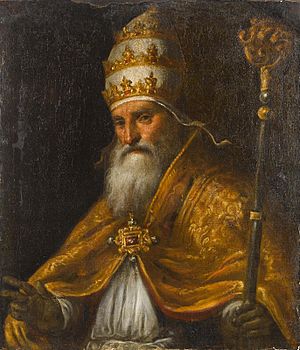
Pius V by Palma il Giovane.
|
|
| Bishop of Rome | |
| Born | Antonio Ghislieri 17 January 1504 Bosco, Duchy of Milan |
| Died | 1 May 1572 Rome, Papal States |
| Venerated in | Catholic Church |
| Beatified | 1 May 1672, Rome, Papal States by Pope Clement X |
| Canonized | 22 May 1712, Rome, Papal States by Pope Clement XI |
| Feast | 30 April (Catholic Church) 5 May (pre-1969) |
| Attributes | Papal vestments Papal tiara Dominican habit |
| Patronage | Valletta, Malta Bosco Marengo, Italy |
Pope Pius V died on May 1, 1572. He suffered from bladder stones but did not want an operation. He also fasted and worked very hard in his last years, which made him very weak. After he died, doctors found three stones in his bladder. He was first buried in a chapel near the tomb of Pope Pius III. Even though he wanted to be buried in Bosco, Pope Sixtus V built a monument for him in the Sistine Chapel of the Basilica di Santa Maria Maggiore. His body was moved there on January 9, 1588.
In 1696, the process to make Pius V a saint began. He was declared "blessed" by Pope Clement X in 1672. Later, he was made a full saint by Pope Clement XI on May 22, 1712.
The next year, in 1713, his feast day was added to the Church calendar for May 5. In 1969, the celebration was moved to April 30, the day before the anniversary of his death.
Cardinal John Henry Newman said that "St. Pius V was stern and severe... Yet such energy and vigour as his were necessary for the times. He was a soldier of Christ in a time of insurrection and rebellion."
The front of his tomb has a gilded bronze lid that shows what the dead pope looked like. This lid is often left open so people can honor the saint's remains.
See also
 In Spanish: Pío V para niños
In Spanish: Pío V para niños
- Cardinals created by Pius V
- List of popes
- List of Catholic saints
- Pope Saint Pius V, patron saint archive


